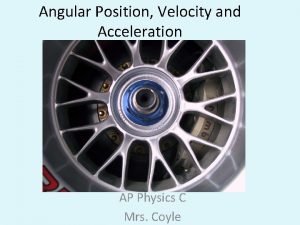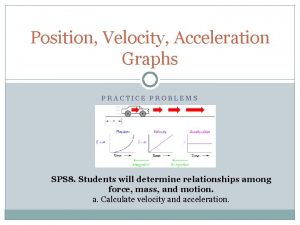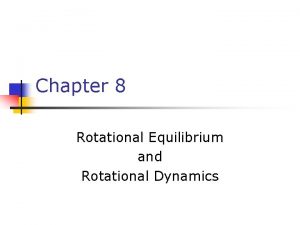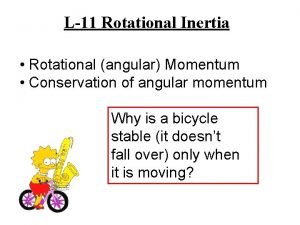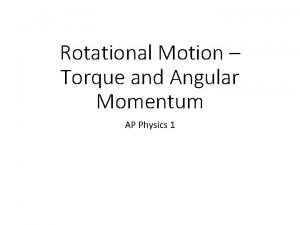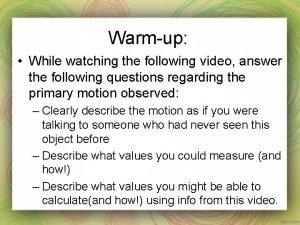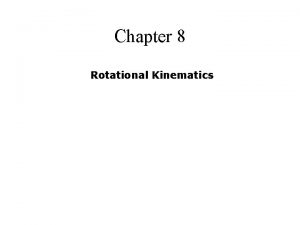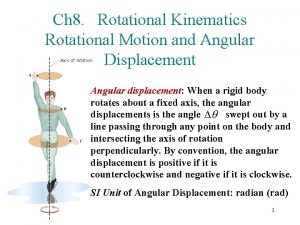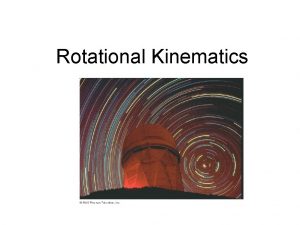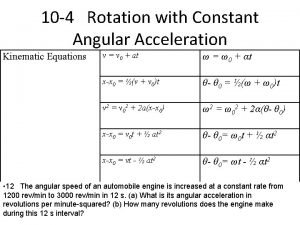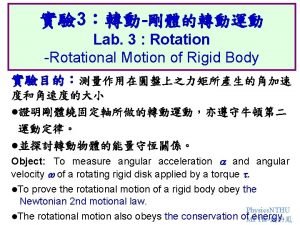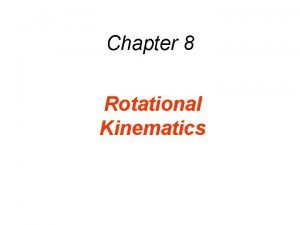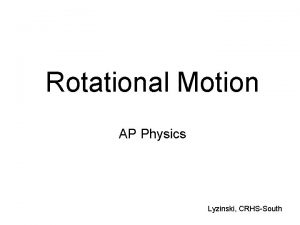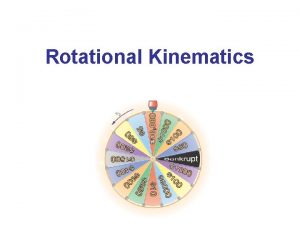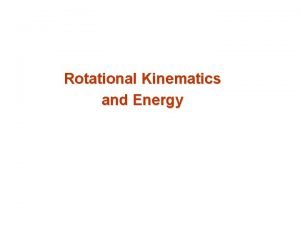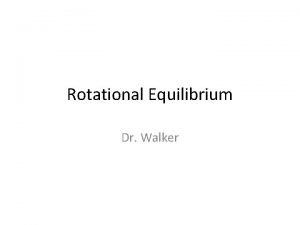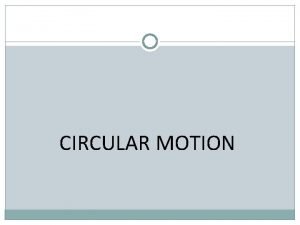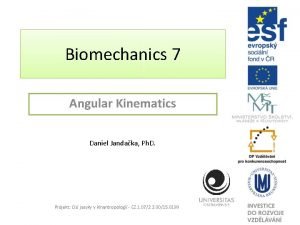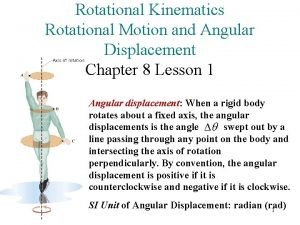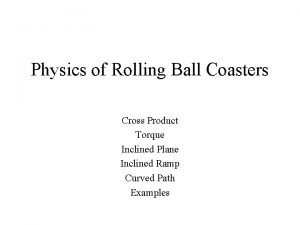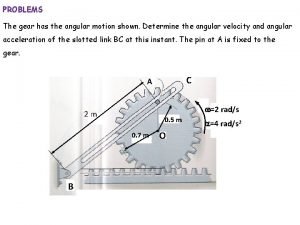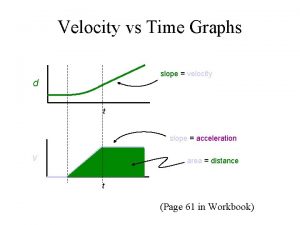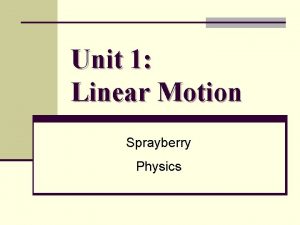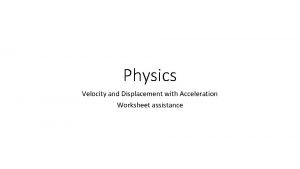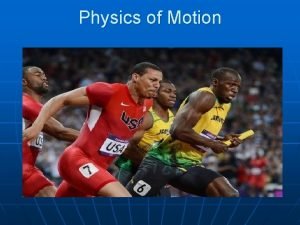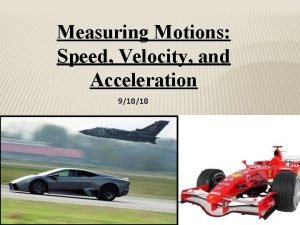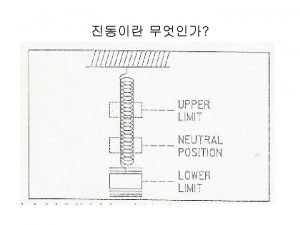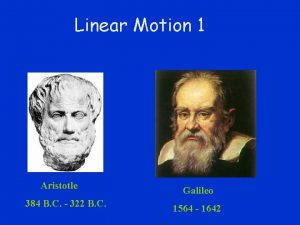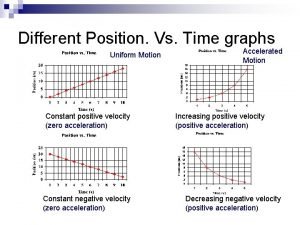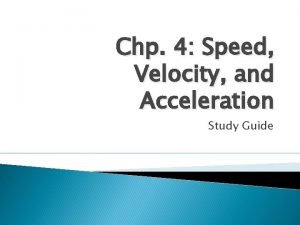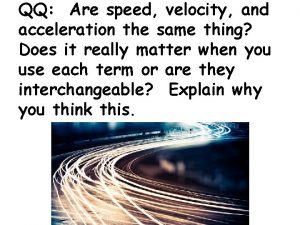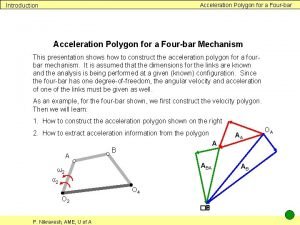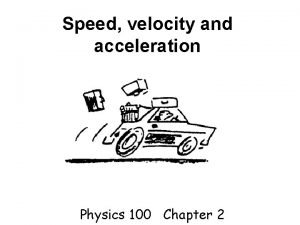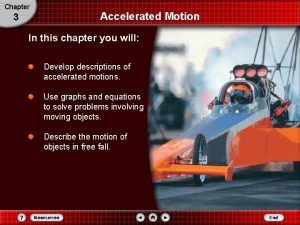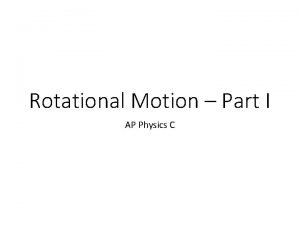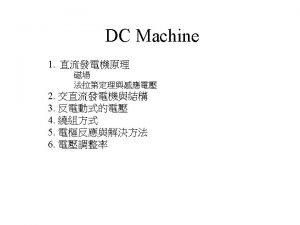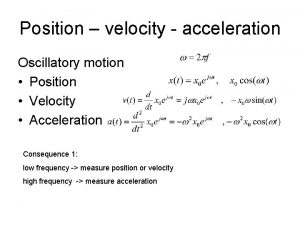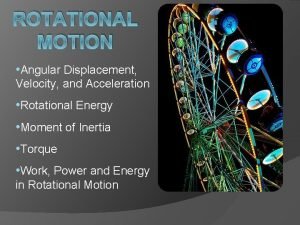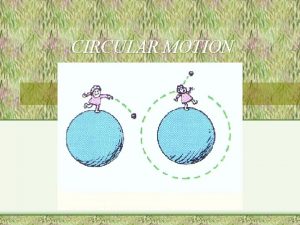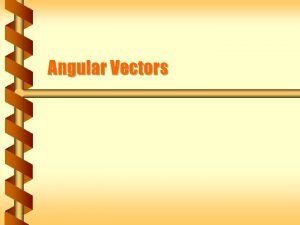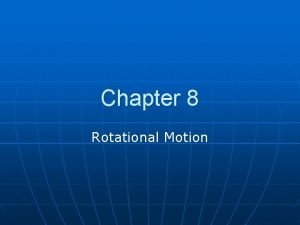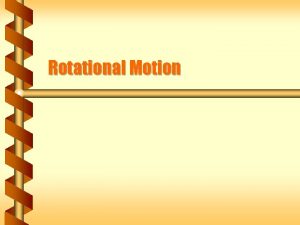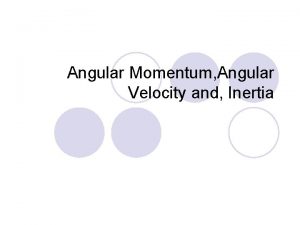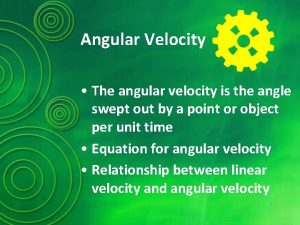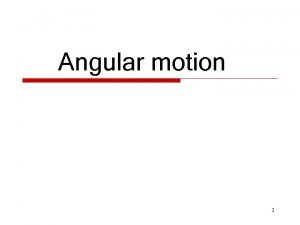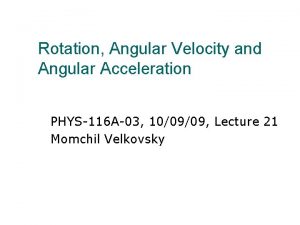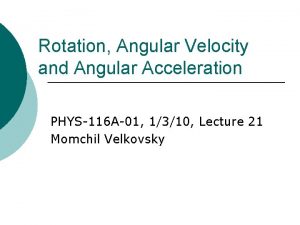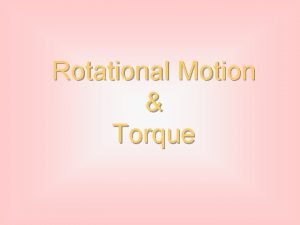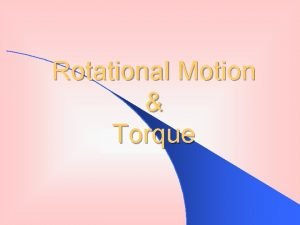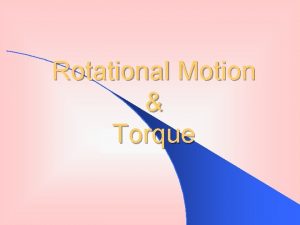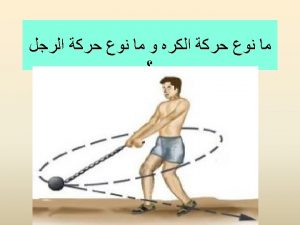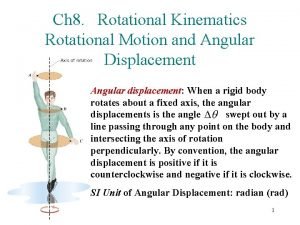Rotational Motion 6 1 Angular Position Velocity Acceleration


























































- Slides: 58

Rotational Motion

6 -1 Angular Position, Velocity, & Acceleration

Angular Displacement (q) Angular Quantities Measured in radians (rad) this unit has no dimensions Counterclockwise is positive 6 -1 Angular Position, Velocity, & Acceleration

Angular Velocity (w) Defined in the same way as velocity Average velocity is displacement divided by time SI unit Instantaneous Angular Velocity 6 -1 Angular Position, Velocity, & Acceleration

Angular Acceleration (a) Defined like acceleration Angular acceleration is change in angular velocity divide by time SI unit Instantaneous Angular Acceleration 6 -1 Angular Position, Velocity, & Acceleration

6. 2 Rotational Kinematics

All the equations used in kinematics (for conditions of constant acceleration) Are exactly the same, but with the new quantities 6. 2 Rotational Kinematics

6. 3 Connections Between Linear & Rotational

For an object moving in a circular path At any given time, the object is moving with a linear velocity tangent to the arc The speed would be circumference divide by the time for one revolution Since w would be 2 p/t 6. 3 Connections Between Linear & Rotational

Similarly we can determine that So in a situation where a spinning object causes linear motion Circumference of the tire Will equal the displacement 6. 3 Connections Between Linear & Rotational

6. 4 Rotational K & the Moment of Inertia

In a spinning object, each particle has kinetic energy Lets assume that we have a rod of uniform mass rotating about its end w v r 6. 4 Rotational K & the Moment of Inertia

Now, just consider a piece of the rod at the very end To calculate the kinetic energy of the mass w v Converting To rotational r quantities 6. 4 Rotational K & the Moment of Inertia

So K depends on angular velocity And it depends on the distribution of mass This mass distribution is called Moment of Inertia w v r 6. 4 Rotational K & the Moment of Inertia

Moment of Inertia varies with shape, mass, and axis of rotation (You will need these to solve problems) 6. 4 Rotational K & the Moment of Inertia

6. 5 Conservation of Energy

We are adding a new type of Kinetic Energy into our existing Energy Equation Adding Rotational Kinetic Energy Where Kr is defined as 6. 5 Conservation of Energy

So if a solid ball is rolling down a slope The equation would become Using the moment of inertia of a solid sphere And the relationship between v and w 6. 5 Conservation of Energy

Example: A yo-yo is released from rest and allowed to drop as the top end of the string is kept stationary. The mass of the yo-yo is 0. 056 kg its radius is 1. 5 cm. Assume it acts as a solid disc rotating around its center. What is the angular speed of the yo-yo after it has dropped 0. 50 m? 6. 5 Conservation of Energy

Example: A yo-yo is released from rest and allowed to drop as the top end of the string is kept stationary. The mass of the yo-yo is 0. 056 kg its radius is 1. 5 cm. Assume it acts as a solid disc rotating around its center. What is the angular speed of the yo-yo after it has dropped 0. 50 m? What quantities remain in the equation below? Expanded equation? Moment of inertia? Solve (remember v=rw) Cancel and insert values 6. 5 Conservation of Energy

6. 6 Torque

Rotational Dynamics – the causes of rotational motion How do we make an object spin Apply a force away from the pivot 6. 6 Torque

The ability to spin increases with force and the distance from the pivot point If the force is parallel to the distance, no rotation occurs 6. 6 Torque

It is the perpendicular component of force that causes rotation This quantity is called Torque (t) And is measure in Nm 6. 6 Torque

As with angular quantities Counterclockwise torque is positive Clockwise torques are defined as negative r r F F 6. 6 Torque

6. 7 Torque and Angular Acceleration

If an unbalanced torque is applied to an object Consider a point where the force is applied The acceleration of that point is 6. 7 Torque and Angular Acceleration

Since We can write this equation as Combining we get Now, math tricks, multiply by r/r The of the fraction is torque, and the bottom is inertia Usually written as 6. 7 Torque and Angular Acceleration

Applying Newton’s second law to rotational motion we get 6. 7 Torque and Angular Acceleration

6. 8 Static Equilibrium

Static Equilibrium How do we calculate the forces needed to support a bridge? The bridge is at static (not moving) equilibrium 6. 8 Static Equilibrium

Using a diagram of the bridge P 1 P 2 W Two conditions for equilibrium 1. The sum of the forces equals zero 6. 8 Static Equilibrium

2. Sum of the torques equals zero 3. For torque we need a pivot point – the actual point does not matter because the object is not rotating 4. Use a pivot point that eliminates a variable 6. 8 Static Equilibrium

The equation becomes P 1 P 2 W 6. 8 Static Equilibrium

Try the problem with some variable P 1 P 2 W The bridge is 100 m long with two pylons that are 10 m from each end. The mass of the bridge is 10, 000 kg. What is the force on each pylon? 6. 8 Static Equilibrium

The bridge is 100 m long with two pylons that are 10 m from each end. The mass of the bridge is 10, 000 kg. What is the force on each pylon? P 1 P 2 W First Condition of Equilibrium 6. 8 Static Equilibrium

The bridge is 100 m long with two pylons that are 10 m from each end. The mass of the bridge is 10, 000 kg. What is the force on each pylon? P 1 P 2 W Second Condition of Equilibrium 6. 8 Static Equilibrium

The bridge is 100 m long with two pylons that are 10 m from each end. The mass of the bridge is 10, 000 kg. What is the force on each pylon? P 1 P 2 W Combine equations 6. 8 Static Equilibrium

A 75 kg man climbs a ladder that is at 60 o to the horizontal. The ladder has mass of 40 kg, is 20 m long and the coefficient of friction between the ground and ladder is 0. 20. How far up the ladder can the man climb before it begins to slip? (Assume that there is no friction at the top of the ladder) 6. 8 Static Equilibrium

A 75 kg man climbs a ladder that is at 60 o to the horizontal. The ladder has mass of 40 kg, is 20 m long and the coefficient of friction between the ground and ladder is 0. 20. How far up the ladder can the man climb before it begins to slip? (Assume that there is no friction at the top of the ladder) Diagram? Dude Wall ladder q=60 o 6. 8 Static Equilibrium

A 75 kg man climbs a ladder that is at 60 o to the horizontal. The ladder has mass of 40 kg, is 20 m long and the coefficient of friction between the ground and ladder is 0. 20. How far up the ladder can the man climb before it begins to slip? (Assume that there is no friction at the top of the ladder) N 2 Force Diagram? Dude Wall ladder N 1 WD WL q=60 o f 6. 8 Static Equilibrium

A 75 kg man climbs a ladder that is at 60 o to the horizontal. The ladder has mass of 40 kg, is 20 m long and the coefficient of friction between the ground and ladder is 0. 20. How far up the ladder can the man climb before it begins to slip? (Assume that there is no friction at the top of the ladder) Force Equations? N 2 Wall ladder N 1 WD WL q=60 o f 6. 8 Static Equilibrium

A 75 kg man climbs a ladder that is at 60 o to the horizontal. The ladder has mass of 40 kg, is 20 m long and the coefficient of friction between the ground and ladder is 0. 20. How far up the ladder can the man climb before it begins to slip? (Assume that there is no friction at the top of the ladder) Pivot Point for Torque? N 2 Wall ladder N 1 WD WL q=60 o f 6. 8 Static Equilibrium

A 75 kg man climbs a ladder that is at 60 o to the horizontal. The ladder has mass of 40 kg, is 20 m long and the coefficient of friction between the ground and ladder is 0. 20. How far up the ladder can the man climb before it begins to slip? (Assume that there is no friction at the top of the ladder) N 2 Distances? 20 m 10 m ladder N 1 WD WL q=60 o f 6. 8 Static Equilibrium r Wall

A 75 kg man climbs a ladder that is at 60 o to the horizontal. The ladder has mass of 40 kg, is 20 m long and the coefficient of friction between the ground and ladder is 0. 20. How far up the ladder can the man climb before it begins to slip? (Assume that there is no friction at the top of the ladder) N 2 Angles? 20 m 10 m q=30 o ladder N 1 q=30 o WD q=30 o WL o q=60 f o 6. 8 Static Equilibrium r Wall

A 75 kg man climbs a ladder that is at 60 o to the horizontal. The ladder has mass of 40 kg, is 20 m long and the coefficient of friction between the ground and ladder is 0. 20. How far up the ladder can the man climb before it begins to slip? (Assume that there is no friction at the top of the ladder) N 2 Torque Equation? 20 m 10 m q=30 o ladder N 1 q=30 o WD WL q=60 o f 6. 8 Static Equilibrium r Wall

A 75 kg man climbs a ladder that is at 60 o to the horizontal. The ladder has mass of 40 kg, is 20 m long and the coefficient of friction between the ground and ladder is 0. 20. How far up the ladder can the man climb before it begins to slip? (Assume that there is no friction at the top of the ladder) N 2 Values? 20 m 10 m q=30 o ladder N 1 q=30 o WD WL q=60 o f 6. 8 Static Equilibrium r Wall

A 75 kg man climbs a ladder that is at 60 o to the horizontal. The ladder has mass of 40 kg, is 20 m long and the coefficient of friction between the ground and ladder is 0. 20. How far up the ladder can the man climb before it begins to slip? (Assume that there is no friction at the top of the ladder) N 2 Value for N 1? 20 m 10 m q=30 o ladder N 1 q=30 o WD WL q=60 o f 6. 8 Static Equilibrium r Wall

A 75 kg man climbs a ladder that is at 60 o to the horizontal. The ladder has mass of 40 kg, is 20 m long and the coefficient of friction between the ground and ladder is 0. 20. How far up the ladder can the man climb before it begins to slip? (Assume that there is no friction at the top of the ladder) N 2 Value for f? 20 m 10 m q=30 o ladder N 1 q=30 o WD WL q=60 o f 6. 8 Static Equilibrium r Wall

6. 9 Center of Mass and Balance

An object is balanced, if the net torque is zero If the rod above is uniform, then when the pivot Wall is in the middle, half the mass is on one side and half on the other This balance point is called the center of mass 6. 9 Center of Mass and Balance

6. 10 Conservation of Angular Momentum

When an object spins, it has angular momentum v Defined as The conservation of angular momentum is treated just like the conservation of linear momentum Conservation of L 6. 10 Conservation of Angular Momentum

So the equation for conservation becomes 6. 10 Conservation of Angular Momentum

Example: A small mass, m, attached to the end of a string revolves in a circle on a frictionless tabletop. The other end of the string passes through a hole in the table. Initially, the mass revolves with a speed v 0=2. 4 m/s in a circle of radius r 0=0. 80 m. The string is then pulled slowly through the hole so that the radius is reduced to r=0. 48 m. What is the speed, v, of the mass now? 6. 10 Conservation of Angular Momentum

Example: A small mass, m, attached to the end of a string revolves in a circle on a frictionless tabletop. The other end of the string passes through a hole in the table. Initially, the mass revolves with a speed v 0=2. 4 m/s in a circle of radius r 0=0. 80 m. The string is then pulled slowly through the hole so that the radius is reduced to r=0. 48 m. What is the speed, v, of the mass now? Using conservation of momentum (only one object) Mass on the end of a string so Masses cancel and we can convert to v Enter numbers and solve 6. 10 Conservation of Angular Momentum

Example: A record player with a mass of 1. 5 kg is spinning at 33. 3 rev/min. The radius of the turntable is 15 cm. A bug with a mass of 0. 25 kg lands 10 cm from the center of the record. What is the new velocity of the record player? 6. 10 Conservation of Angular Momentum

Example: A record player with a mass of 1. 5 kg is spinning at 33. 3 rev/min. The radius of the turntable is 15 cm. A bug with a mass of 0. 25 kg lands 10 cm from the center of the record. What is the new velocity of the record player? v The record player is a solid disk, the bug is a point mass Convert rev/min to rad/s Substitute and solve 6. 10 Conservation of Angular Momentum
 Angular position velocity and acceleration
Angular position velocity and acceleration Relation between angular and linear quantities
Relation between angular and linear quantities Linear acceleration vs tangential acceleration
Linear acceleration vs tangential acceleration Angular velocity to tangential velocity
Angular velocity to tangential velocity The law of universal gravitation states that
The law of universal gravitation states that Is v final velocity
Is v final velocity Final velocity initial velocity acceleration time
Final velocity initial velocity acceleration time Position velocity acceleration graphs practice
Position velocity acceleration graphs practice Rotational equilibrium example problems
Rotational equilibrium example problems Rotational equilibrium and rotational dynamics
Rotational equilibrium and rotational dynamics Rotational angular momentum
Rotational angular momentum Second position ballet
Second position ballet Theorem of angular momentum
Theorem of angular momentum After watching the video answer the following questions
After watching the video answer the following questions Si unit of angular acceleration
Si unit of angular acceleration Unit of angular acceleration
Unit of angular acceleration Angular acceleration unit
Angular acceleration unit Constant angular acceleration
Constant angular acceleration Constant angular acceleration
Constant angular acceleration The five kinematic equations
The five kinematic equations Translational and rotational motion
Translational and rotational motion Angular acceleration
Angular acceleration Difference between linear and angular acceleration
Difference between linear and angular acceleration Centripital acceleration
Centripital acceleration Radial acceleration definition
Radial acceleration definition Centripetal acceleration tangential acceleration
Centripetal acceleration tangential acceleration Angular velocity and inertia
Angular velocity and inertia Angular velocity formula
Angular velocity formula Angular velocity biomechanics
Angular velocity biomechanics Displacement in uniform circular motion
Displacement in uniform circular motion Inductive transducers
Inductive transducers Velocity cross product
Velocity cross product Determine the angular velocity
Determine the angular velocity Area under velocity time graph
Area under velocity time graph Linear motion definition
Linear motion definition Velocity
Velocity Speed, velocity and acceleration quiz
Speed, velocity and acceleration quiz Speed, velocity and acceleration problems
Speed, velocity and acceleration problems Unit of relative velocity
Unit of relative velocity Displacement and velocity worksheet
Displacement and velocity worksheet Difference between velocity and acceleration
Difference between velocity and acceleration What is velocity
What is velocity Velocity acceleration derivative
Velocity acceleration derivative Vibration displacement velocity acceleration
Vibration displacement velocity acceleration How is velocity different from speed
How is velocity different from speed Quickchek menu
Quickchek menu Negative velocity negative acceleration
Negative velocity negative acceleration Tvtat
Tvtat Speed velocity and acceleration study guide answers
Speed velocity and acceleration study guide answers Velocity and acceleration polygons
Velocity and acceleration polygons Velocity describes
Velocity describes Are speed and acceleration the same thing
Are speed and acceleration the same thing Speed, velocity and acceleration notes
Speed, velocity and acceleration notes The fan blade is speeding up. what are the signs of
The fan blade is speeding up. what are the signs of Velocity polygon
Velocity polygon Velocity and acceleration
Velocity and acceleration The velocity changes from 45m/s
The velocity changes from 45m/s Accelerated motion chapter 3 answers
Accelerated motion chapter 3 answers Ap physics c rotational motion
Ap physics c rotational motion
